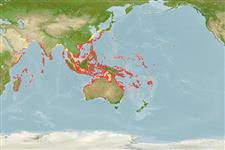Classification / Names
Common names from other countries
Main reference
Size / Weight / Age
Max length : 38.0 cm TL male/unsexed; (Ref. 55); common length : 30.0 cm TL male/unsexed; (Ref. 5450); max. reported age: 31 years (Ref. 34051)
Environment
Marine; reef-associated; depth range 2 - 40 m (Ref. 9710)
Climate / Range
Tropical, preferred 27°C (Ref. 107945); 35°N - 37°S, 42°E - 176°W (Ref. 55)
Distribution
Indo-West Pacific: Persian Gulf and the Gulf of Oman to Fiji, north to southern Japan. This species has been referred to as Lutjanus spilurus.
Countries | FAO areas | Ecosystems | Occurrences | Introductions
Short description
Dorsal
spines
(total): 10;
Dorsal
soft rays
(total): 13-15;
Anal
spines: 3;
Anal
soft rays: 8. Dorsal profile of head steeply sloped. Preorbital width usually less than eye diameter. Preopercular notch and knob well developed. Scale rows on back rising obliquely above lateral line. Generally bright yellow, including fins, with a series of blue stripes on the side. A round black spot, about the size of the eye or larger, is below the anterior most soft dorsal rays, touching the lateral line but mostly above it (Ref. 469). Body depth 2.3-2.9 in SL (Ref. 90102).
IUCN Red List Status (Ref. 115185)
Threat to humans
Harmless
Human uses
Fisheries: commercial; gamefish: yes; aquarium: commercial
More information
ReferencesAquacultureAquaculture profileStrainsGeneticsAllele frequenciesHeritabilityDiseasesProcessingMass conversion
Tools
Special reports
Download XML
Internet sources
Estimates of some properties based on models
Phylogenetic diversity index
PD50 = 0.5000 many relatives (e.g. carps) 0.5 - 2.0 few relatives (e.g. lungfishes)
Trophic Level
3.7 ±0.2 se; Based on diet studies.
Resilience
Very Low, minimum population doubling time more than 14 years (tmax=31; k=0.30)
Vulnerability
Low to moderate vulnerability (34 of 100)
Price category
